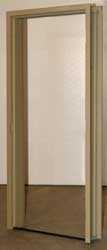|
|
Emergency Exit Doors
Emergency exit doors are not intended to be used by pedestrians entering
the building. Characteristics that enhance the physical security of exit
doors include:
- They open outward directly to the outside.
Typically, these doors are fire exits, so they must never open
inward (fire codes prohibit
this).
- They have no exterior-mounted opening hardware.
Because exit doors are never supposed to be opened from the outside,
don’t increase
their vulnerability by including a lockset or latching hardware that
could be attacked from the outside.
- They have a tamper-resistant astragal
to prevent the latch from being slipped from outside. Because the
door opens
outward, there is a space between the door and the strike jamb.
This space exposes the latchbolt
to manipulation. A strong astragal prevents someone from inserting
a shim device to externally manipulate the latchbolt or emergency
opening mechanism.
- The hinge pins cannot be removed and security
studs have been installed. Because the door swings outward, the hinge
pins are on the insecure
side, the outside. If the hinge pins were removable, it would be
a simple matter to remove the door and gain access.
- Hinges should
have safety studs. Safety studs extend from one hinge leaf. A hole
is punched in the corresponding position on the opposite
leaf. When the door is closed, the stud sits in the hole. Even
if the hinge pin were removed, the door still cannot be taken off
its hinges
because the stud holds it in place.
- Local alarms on the bar openers
that retract the latchbolt and open the door.
- A sensor (such as a
concealed magnetic switch or a concealed pressure release switch)
that generates an immediate alarm whenever the door
is opened. Employees sometimes use emergency exit doors as convenience
doors. Often, an emergency door is propped open to allow employees
to return. Persons gathering intelligence for attackers and the
attackers themselves love to see human errors such as these.
- Emergency
exit doors should be metal doors set in reinforced metal frames.
The outside of the door should be flush with the outside
of the frame to prevent frame spreading. Metal doors in reinforced
metal
frames are more resistant to forced entry than solid core wood
doors. Properly maintained, metal doors will hold up better to weather.
|





